Through a series of unlikely events, Steven Frank was able to master the near-unwinnable Dragon’s Lair when he was a kid. And for one day, it made him a God amongst kids.
I was obsessed with Dragon’s Lair, and its spiritual science-fiction sequel Space Ace. (A true sequel, Dragon’s Lair II, is lesser known as it arrived almost exactly as the last remaining arcades were being shuttered. I only ever saw it in the wild once.) I was an animation nerd, and a video game nerd, and here were these games right at the intersection.
Like everyone else, I wasted a lot of my parents’ quarters playing Dragon’s Lair and lasting for about 2 minutes before losing all five lives. Fortunately, the local grocery store had a Dragon’s Lair cabinet, as well as a couple of other games, so I got many occasions to practice.
One day I was sitting in our apartment reading a video game magazine (nerd!), and in the back was a little section of classified ads. My eye was caught immediately by the words “Beat Space Ace and Dragon’s Lair!” For a few bucks, you could send away for this random guy’s strategy guide, which listed all the moves and when to make them.
Please realize there was no residential internet. We had a computer, but no modem. There was no just going to Google for an FAQ or walkthrough. If you didn’t know the moves, you just didn’t know them, unless you knew someone else who knew them, which of course you didn’t.
I begged my parents. Weeks later, my strategy guide arrived (a few black and white photocopied sheets of paper stapled together), and I began studying.
The feeling Frank had at the end of the story, of awing the crowd and then walking away from that machine like Will Smith walking away from an exploding alien spaceship, is a sensation that 1980s nerds didn’t often feel. When the web came around in the 1990s, it provided a similar, but much larger, opportunity for nerds. On the very public stage of the web, the nerds of the world finally had something to offer the world that was cool and useful and even lucrative. The web has since been overrun by marketers, money, and big business, but for a brief time, the nerds of the world had millions of people gathered around them, boggling at their skill with this seemingly infinite medium. That time has come and gone, my friend. (via df)
Since Thanksgiving is all about remembering what and who we’re thankful for I thought it would be appropriate to celebrate Thanksgiving by gathering and sharing stories from readers about how kottke.org, and the internet generally, connected them with people. Thank you so much to everyone who shared their stories.
Happy Thanksgiving, all!
Heather Armstrong:
Jason’s blog was the first I ever read and what inspired me to start my own in February 2001. I was really stupid back then (as opposed to now? SHUSH) and wrote a lot of what I thought were funny stories about my family that were in fact kind of horrific. A few months into it I wrote Jason an email asking for advice and he responded! He was like, “Hi. You’re kind of funny. But your family is totally going to find your website, you know this, right?” My mom didn’t know how to turn on a computer at the time, so I just laughed and laughed, and then they all found my website the day after I wrote a scathing diatribe against the religion my parents had raised me in. The whole family exploded.
Jason, he is wise.
Then he linked to my site. My traffic tripled. That was the first bump in visitors I ever saw. Now my website supports my family and two employees.
When I visit New York I try to stop in and say hi to Jason and Meg and their two beautiful kids.
M. Lederman:
Around twenty years ago, I was sitting at my home desk looking at my first ever personal computer. This was a particularly sad time in my life and the thoughts running through my head were leaning towards the end of things rather than beginnings. I happened to click on a story about web communication and one click led to another and I ended up at a telnet chat site called, “Spacebar”. There were but a few people there as it was after midnight here in Texas, and one with a name of, “shena” happened to be in the same chat room as I was. I sent shena a chat request which was ignored and thought I was doing something wrong, then I sent the message, “do you want to chat or are you just lurking” and shena began a conversation with me that lasted a few hours. We made plans to chat the next day and then the day after.
Shena turned out to be a lovely girl living in Australia who chatted with me for about two years on a daily basis before one Christmas holiday when I called her to wish her a happy holiday. Now twenty years have gone by and we have grown to know each other very well, chatting nearly daily sometimes for many hours and sharing each others very different lives. I consider her my closest friend and confidant and now cannot imagine a life without her in it. We’ve shared so many important moments in each of our lives growing closer with each new communication invention from telnet chat and email, to ICQ then AIM, VOIP phone calls to Skype where we can talk and see each others reactions to our statements. If technology had given me just this without all the rest I would have been satisfied so without the Internet I would not have this lovely lady in my life.
Atanas Entchev:
I remember exactly how and when I found kottke.org. It was Saturday, February 12, 2005. I had a Flickr meetup with several Flickr friends for the opening of The Gates in NYC’s Central Park. My Flickr friend Gene Han (whom I had known from Flickr for a while, but never met in person until then) told me about kottke.org. The rest is history.
Last week Jason wrote a post about My American Lemonade — my book about my family’s 18-year (and counting) US immigration ordeal. I am looking for a publisher, and Jason’s post has already resulted in several inquiries. Connecting people.
Tony Williams:
My tale of people connecting starts many years ago in the nineties.
There is a six year age difference between my brother and I and I was 12 when he went away to University, first in Canberra (I was living in Sydney) and then overseas in Rochester, New York before he finally settled in Boston. We had never been close but when we both had access to email in 1991 we started a correspondence that created a real relationship that we had never had before. It got to the point where we would correspond at least once a week or so.
On top of this I have the usual tale of finding long lost friends via social media. One friend I hadn’t seen since we both lived in Newcastle, NSW when I was 12 who now lives in Los Angeles, we hadn’t been in contact in almost forty years until I found him on LinkedIn.
I recently had coffee with a bloke I hadn’t seen in thirty nine years who found me on Facebook.
Tracie Lee:
I read your post and i was like, OMG kottke.org was my people connector and led to my work life for the past five years. I’ve been following kottke.org since 2003, maybe? at least. I’m definitely more of a lurker. In 2007 Jason posted about a job at Serious Eats and I applied. I didn’t get the job, but through Alaina (the general manager) I was introduced to David Jacobs and John Emerson. Long story short, I started working at their company (Apperceptive) and then Six Apart, and consequently met everyone IRL (Jason, Meg, David, Adriana, Alaina, Anil) and became friends with them. All because I answered a job posting on Jason’s site! And to come full circle I’ve been working on Serious Eats for the past two years as their designer.
The internet is an amazing place for sure.
Amanda Dicken:
My people connection started way back in 1997, when I moved from Ohio to Florida in the middle of my junior year of high school. My parents felt terrible about it, and tried to make me feel better by installing AOL to the brand new computer they had bought to put in my new bedroom (they were REALLY trying to make me feel better). I had just made friends with a girl named Becky, who sat in front of me in our homeroom. She was one of the first people I met and had a lot in common with. One day when I told her I had AOL, she said she also had it, and had made friends with a lot of people online. She got my screenname, and that night, Instant Messaged me and gave my screen name to two guys she frequently talked to, Chad and Tim. She had met them through a couple “topic” chat rooms on AOL. She met Chad through a comic chat room, Tim through another one I can’t remember. She told me they were a ton of fun to talk to, and would cheer me up. So I started talking to both Tim (from Seattle) and Chad (from North Carolina), both around my same age. Over the years, I lost contact with Becky, but kept in great contact with Tim and Chad, talking on the phone every so often with both of them throughout all of college (I graduated in 2002).
In late 2003, Chad asked me if I was planning on staying in FL, which I wasn’t sure at the time. He was looking to move to Raleigh to look for a career in the technology field he had studied in college, needed to find a place and a roommate, and thought I would be perfect. So, I flew up to NC in January 2004, had a great time, and we started dating soon after. He found us a great place in Raleigh, flew down to FL to get me, drove back up here with me and we’ve been together ever since. We bought our first house together a couple years ago nearer to his family after we got our careers settled, and couldn’t be happier. Tim is still a good friend of mine, although we don’t talk as much as we used to. I’ve also never met him in person, as strange as that is. Chad and I found out a few years ago that Becky had moved to Charlotte, NC! Small world. We travel down to FL to visit my fam about twice a year.
Anyway, that was my fun story I wanted to share! Every time we’re watching TV and see a commercial for one of those dating sites, I always say we made dating online cool before it was acceptably cool to do so.
John Edwards:
I used to write regularly for SeriousEats.com which does an annual cookie swap at the holidays. At that event a few years ago, I met Ollie Kottke, Jason’s son. He was standing by one of the cookie tables, and I said “Hey guy, how’s it going?” He did what most toddlers would do: looked at me with a fearful stare for a moment, then ran to his mother and wrapped his arms around her leg. I was introduced to Meg, Ollie’s mom and Jason’s wife, and I think I gave her a fist bump, because my hands were covered in chocolate. They told me she helped get Serious Eats off of the ground, and that her husband was a famous internet guy. I continued to munch my cookies.
Through Serious Eats, I met Adam Kuban, the founder of Slice. He would always comment on my posts on Serious Eats, and say constructive, positive things about my work. We traded tweets (and still do) and he often favorites my random musings, something I must say is a tremendous confidence boost. Honestly, receiving the “Adam Kuban favorited your tweet” email is a sheer pleasure. He was one of the most delightful and encouraging people I’ve ever met on the internet, even though in person he can appear grumpy.
In August of last year, Adam Kuban tweeted something about having Stellar invites. I had seen @yo_stellar mentioned many times on Twitter, but I didn’t know what it was. I visited stellar.io, and was intrigued by what I found. I read about it, Jason, and kottke.org.
I told Adam I wanted an invite to Stellar, and he gave me one. I evangelized Stellar to my coworkers at a tech startup. You know, the type of people who like internet things. One of them and I started regularly favoriting things to fill our Stellar feeds. We also became daily readers of kottke.org, and traded links to things we found.
In March/April, I decided to leave my job. I didn’t know what I wanted to do next, so I asked myself “what would I do if I didn’t have to do anything?” The first thought in my mind was “work as a developer on Stellar. Like an intern.”
So I cold-emailed Jason. I tried to be as nice as possible, and I explained why I wanted to work on Stellar. Bear in mind, I had never met him, I had never seen him, I had never spoken with him. He was just this person tangentially in the Serious Eats world that I kept hearing about. Surprisingly, he agreed to meet me, saying he’d been thinking about having a Stellar intern, but wasn’t sure what that person would do.
Surprisingly, about a week later, an email popped into my box accepting me as an intern, and showing me the basic steps of how to get a version of Stellar running on my local machine.
Jason is a laid-back guy, and it has been fun to work with him.
Lauren von Gogh:
I found out about kottke.org through Jon Bernad. It is his favorite website. I’m not sure how he first came across it. I met Jon through the internet. He had one post on a really bad blog he had made with a brown and beige background and curly writing. It offered a free Birthright Trip for someone who had never been to L.A. before and who had never met Jon. I emailed him from Johannesburg, where I live, sharing some anecdotes about my life that would hopefully put me in line for the trip. I didn’t hear anything back from him, and forgot about it completely.
9 months later I received an email congratulating me, telling me I had been chosen! Birthright Trip transformed to Leap Trip, which started on February 29th. I flew to Washington D.C., where Jon grew up. We met at the airport for the first time, without ever having been in direct contact with each other. We stayed with his dad for a couple of nights and then his mom, before driving the car his dad gave him across the country, back to L.A. where he lives now.
The idea of driving across the USA was so wild, and something I’d never expected to have done in my life. To meet a complete stranger, and then drive across the country together isn’t something I could’ve ever dreamed up. That this complete stranger was not a psychopath, but rather the most enthusiastic, generous and mysterious character I’ve ever met, was a bonus. It was a life changing experience.
I flew out of L.A. on April 1st after spending two weeks there and the two weeks before passing through D.C., Baltimore, Philadelphia, New York, Knoxville, Boaz (Alabama), New Orleans, Houston, Austin, Marfa, and the White Sands National Park.
I completely fell in love with L.A. and actually went back for the summer. And Jon and I still speak every day
Allen Knutson:
Before the World Wide Web, there was a thing called USENET. You can get a small sense of its sensibilities here.
I was highly active on the newsgroup rec.juggling; indeed in ‘92 or ‘93 I was its biggest loudmouth (somebody was keeping track on a yearly basis). When I decided I wanted to go to the 1993 European Juggling Convention, and before that to the Edinburgh Fringe Festival, I put out a “Can I sleep on your couch?” to thousands of people I didn’t know, but who apparently felt knew me. Some said yes, and I got to stay in a house of young jugglers *with net access* (no small thing then!).
Erin Kelley:
I met my best friend Isaac Watson via Livejournal in 2005. We both needed roommates and upon meeting clicked in a way that I’ve experienced with so few people. I introduced Isaac to Google Reader and to Kottke… or did he introduce me? I don’t know but we bonded over sending each other different Kottke posts that we’d each already read in our own feeds. The intersection of our interests—the Liberal Arts 2.0 concept—curated on the site allowed us many hours of discussion and exploration of the interests we share . And after I moved away, Isaac and I used the shared links feature in Google Reader too. The discontinuation of that feature was very unfortunate.
Reid Young:
I made my first webpage in middle school (1997) about a video game called EarthBound. Within a few years it had grown into a small online community, so I convinced my parents to let me hold a ‘convention’. Four friends from the site traveled to my family’s farm in Indiana to hang out for a weekend, and virtually every aspect of my life has been subsequently shaped by that website/community.
The conventions grew quickly, and within a few years became a yearly weeklong group vacation. In 2004 I married an awesome girl who attended that first convention (our first child is due in January). In 2008 I teamed up with a bunch of other friends from the community to start a business making merchandise inspired by old video games (like/including EarthBound). I now work with nearly a dozen friends and family, virtually all of whom are EarthBound fans I met through that website.
Hamza El-Falah:
I too don’t remember how I was connected with Kottke, but most likely it was a result of some cross-linkage between his site and Daring Fireball, my two most frequented sites.
Kottke turned me on to clusterflock via their first iPhone Giveaway. I thought it was a really cool idea: everyone pitch in a few bucks, and if they made enough money to pay for an iPhone, one of the contributors would get it. I was a student at the time the first iPhone was being released and couldn’t afford a $500 phone, so I figured either I’d get an iPhone for next to nothing, or at least help someone else get one. Win-win.
Lo-and-behold, I was chosen as one of the winners! I was so excited. I actually received $500 in my PayPal account. Crazy. I was already a fan of Apple, but this cemented my love and I’ve purchased every damn iPhone every year since. :)
Merinda Brayfield:
Around about 2005 I learned of this thing called National Novel Writing Month. Through that I found the chat room and it became a second home, at least for a while. Among the people I met in this chat room, a few of us met up sometime later when a bunch of us happened to be in Hawaii at the same time. And, even more important I met the gal who is now my roommate, who moved halfway across the country in the hopes of finding a job and did within three weeks after a year of searching. She’s now lived with hubby and I for a year, and we don’t mind her staying.
Colter McCorkindale:
It all started with an album cover, really: “Electric Pocket Radio” by The Incredible Moses Leroy. I was killing time at Barnes & Noble so I took a listen. I loved it so much that I bought it and a few days later decided to start a page for them on Orkut (remember Orkut?). The only other person who joined was a girl in Indiana named Jamie. We became very close friends despite the fact that I lived in Arkansas. We sent each other CDs and zips of mp3s and my favorite disc of the bunch was for a band called Spiraling. By then she and I had moved over to MySpace, and we connected with Spiraling. I pestered a local club owner to give them a gig, and eventually they came through town and played some shows. I took them to a house party and we became friends; they’d stay over at my house. Eventually I got them hooked up with a gig opening for Switchfoot at the annual Arkansas Riverfest.
In 2006, I went to New York City for a short vacation, and caught up with the Spiraling guys (they’re from NJ and Brooklyn). I went to a Halloween party at the bass player’s apartment. Somebody said they thought I was from NYC, and that got me thinking that I could be. I figured I could give it a try, since I have friends in the area and by that time Facebook was on the ascendant, so I could stay in touch with everybody in Arkansas. And my music collection was so digital by then I could take my massive music collection with me. So I moved to NYC in 2008. I thought maybe I would be a temp for a year and hate it and go home, but that was 5 years ago. I have a great job in web project management at a major credit card company, one that allows me to work remotely from Arkansas whenever I want so I’ve been going back and forth.
From an album cover to a girl to a band to a city and back again. Thanks, Internet.
Samantha Port:
For about six years now, I’ve been a big fan of the musician Amanda Palmer. About a year into my obsession with her, I realized she was using Twitter a lot, so I opened an account to follow her. One Friday night, she made a joke about her and her fans all being active and chatting with each other being the Losers Of Friday Night On Their Computers. This VERY quickly turned into the hashtag #LOFNOTC, a T-shirt design was drawn up using Sharpie and they started presales that night, and it formed a large group of her fans under the #LOFNOTC tag who continued to get together every Friday night whether or not she was involved, not just chatting over Twitter but even opening up video chat rooms on Tinychat. I became a part of this group, which, over time, lost numbers, but grew even more tightly knit because of it.
The people I met through #LOFNOTC introduced me to other interests and, in turn, other people. Through my friend Katy, I found a fantastic Sherlock Holmes roleplay all done on Twitter (@SHolmesEsq and @MyDearestWatson, if anyone is curious), and through them, I met other people. There are dozens of people I am proud to call friends who I never would have met if it were not for Amanda Palmer and her accidental creation. The last time I got to speak to her in person (she tries to do meet-and-greets after every single show), I thanked her for creating #LOFNOTC and bringing all these wonderful people into my life. Sadly I’ve lost most contact with a lot of them over the past couple of years, but I still am rather close with quite a few of them and of course to the people I’ve met through them. It’s hard to stay close with an entire group of 30+ people for so long. All of them, and her as well, have changed me for the better. I simply wouldn’t be who I am today without those experiences.
Eno Sarris:
I’m a former educational publishing editor who used to spend way too much of his time on google reader reading about baseball. I ended up befriending a particularly awesome little corner of the formerly superlative google reader social circle, one that was often referred to as the Google Mafia or the Sharebros more self-deprecatingly. Mostly headed by Jonah Keri (now of Grantland.com on ESPN), the group shared the most interesting writing, inspiring me to work harder on my then-hobby of baseball writing. I also grew closer to many of the people in that group, often when using the formerly sweet social functions of google reader sharing — I argued and shot the shit over kottke posts when I should have been creating three-word sentences with rhyming words. Since those days, I’ve left my comfortable job and struck out into freelance sports writing, and with the help of many of those sharebros, I’ve managed to cobble together a (more personally rewarding, if not quite financially lucrative) living. I hope I’m living up to those standards that would have gotten me a share among the mafia back in those days. Without sites like twitter, breaking into the scene wouldn’t have been possible, and back in the pre-twitter days, many of the obstacles to becoming a sports writer would have (once again) sent me in the wrong direction. Lowered boundaries to access, easier networking, and more rewarding content — that’s how the internets (and kottke and twitter and the old google reader specifically) have helped connect me to a better job.
Joseph Kelly:
I’m sure your response bag must contain stories from Craigslist. [ED: Surprisingly no! Cause I’ve also made some great friends through CL.] I’ve found no greater tool in the United States for solving your needs that also threads you to some other side of the Universe to connect with random new people.
Several years ago I decided to start building websites for other people. I would hunt the Gigs section for projects and first met Abe. Abe wanted to build a website, Abe’s Apartments, to provide an easy online listing service for apartment seekers in Austin. I couldn’t build him what what he wanted and told him as much. Years later my business partner would help him out. Abe and I connected over shared experiences and outlook on travel and have become great friends.
Another time I wasn’t qualified to build the website for a Craigslist ad, I interviewed to design the web content management system for the Center for Non Linear Dynamics in the Physics school at UT Austin. Two of the grad students who interviewed me would go on to cofound our company, Infochimps, where the 3 of us have been partners for nearly 4 years. They are some of my best friends and we consider it a great irony that after I interviewed to build them a website they spent the next 3 years building our original site at infochimps.com.
At some point one of my cofounders would build for Abe the prototype of Abe’s Apartments. In the end we got all our needs met and are connected, thanks to Craigslist.
Michael Botsko:
In 2011 I started a Minecraft server so that my son and a few coworkers could play with me and eventually I decided to open it to the public, just to see what happened. I expected to find a few parent/kid groups at most.
Although I’ve recently decided to stop the server for many reasons, this little server grew into a behemoth with between 350-500 players every single day, over 18,000 in about 18 months. It’s just blown my mind how many countries, timezones, and cultures were represented on the server and even though it’s all digital and still mainly anonymous, many of our players made some really good friends.
The sheer volume of responses with people saying how great a job I had done, how this server had such a large impact on their lives, was fairly overwhelming.
Ben Capozzi:
Last year at this time, I was in education teaching art + design. There was a great piece I thought students would respond to ‘An Open Letter to Graphic Design Students: Don’t Follow the Web, Follow Your Heart’ by one Timothy O Goodman. The piece was great, and lead me to another piece by him, New York vs California.
I decided to reach out to Tim on Twitter and via his site’s email address to see if he would share a meal with us in the city the following March when I would be bringing a small group of students with me to NYC for our 3rd annual ‘Design Junket’ where we introduce students to creative professionals across several disciplines.
Tim’s not only talented, he’s super friendly and said ‘yes’ to my request. We took him to lunch to dine finely on the rooftop of Eataly, where he patiently and enthusiastically sat among 10 students from high school and community college for about an hour and a half.
The internet (and generous community support) made that possible. That trip always changes students’ perspectives and shows them how big and wonderful the planet is. You can live in rural Virginia and arrange a lunch in NYC with a world class professional. That’s pretty cool.
Alicia Yang:
As a junior in high school, social media has really been an interesting “people connector.” Because I moved from the East to the West coast after freshman year, I like having friends from both areas in one place on facebook. All of my AP classes have facebook groups, which makes it easy to collaborate and ask questions (without risk of cheating, since nobody is going to use a public forum to cheat). Because I go to a huge high school now, sometimes I meet people once at a party or something and really connect with them, but I rarely get to see them around school. For these kind of acquaintances, facebook is enough to connect with each other. However, social media isn’t that great for actually forging close relationships or having real conversations. Specifically for twitter, which I think is a great medium for sharing ideas and thoughts, I feel like it’s not really a people connector since tweeting is more talking at people than to people.
I found kottke.org on a list of blogs to follow in Time magazine. It hasn’t really helped me connect with people (haha, I don’t really talk to people about, say, kottke and Time because typical high school students aren’t really into this kind of thing) but it introduced me to David Foster Wallace and Infinite Jest, which is definitely one of my favorite books now. :]
Bill Connell:
There’s a saying that Facebook is for finding old friends, and Twitter is for finding new ones, and it has definitely worked that way for me. Last night is the perfect example of this: i went to a friends house for dinner and drinks, and the 4 other people there were all folks the host knew initially through Twitter. I got to meet a local journalist, an elementary teacher at a controversial charter school, and an entrepreneur starting up a new brand of Akvavit, all fun and interesting folks. I initially met the host when a mutual Twitter friend had invited us both to a meetup several months ago to celebrate a new work venture he was starting. This year i have been on bike rides and happy hours and fish frys and housewarming parties for people i never would have met without Twitter because our circles in real live wouldn’t otherwise overlap.
Brian McNely:
Just saw your post on Kottke (via Reader). A colleague and I actually wrote an article about lightweight blogging + Reader + Twitter as a people connector for extending undergraduate classrooms back in 2010.
It was cowritten by me (in Indiana at the time), a colleague (in New Jersey at the time), two undergraduate students at my institution (one was an enrolled student, one wasn’t), and a community member and contributor to the class (located in Kansas City, and unaffiliated with any of us in any way, save for connections through Reader and Twitter, and a shared interested in the things we mutually shared).
I don’t spend a lot of time lamenting the loss of Reader’s social features (companies create these things, we use them for free, and sometimes they go in a different direction—meh), but I do have to say that it was probably my favorite SNS ever (and I’ve been adopting and studying how people use SNSs since 2007).
My mom, Susan Pavis, emailed me a story that had slipped my mind & goes a ways to explaining why I’m so interested in this stuff:
This story shows that nothing is ever gone from the internet. My daughter (the now famous Sarah Pavis [ED: ugh! mom…]) was doing a project on earthquakes when she was in the 4th or 5th grade. One of the components of the project was to survey people on the topic. Living on the east coast we had never been in nor knew anyone who had experienced an earthquake. The Kobe Japan earthquake in 1995 had just occurred. We used a couple of different earthquake newsgroups (yes, there was more than one newsgroup devoted to earthquakes) to post a survey with some basic questions. This was cutting edge back then and she even got props from her teachers that she had used a ‘new medium’ to gather her information. We had a wonderful response from people from all over the world. I was very impressed that so many people responded to the survey - we even received a couple of responses from people in Kobe. My email was used to have people send back their completed survey. I can remember after about 10 years still getting email responses to the survey!!!
And in a surprising twist, requesting people connections reconnected me with someone I haven’t seen in years: my childhood neighbor, Liam Aiello.
I’ve been reading kottke for some years now, so perhaps you can imagine my surprise when your name appeared in my feed. Sarah Pavis, guest editor? Didn’t she grow up in Middletown CT? If so, what a fine coincidence.
My name is Liam, and I grew up on the same street. There were a handful of us, as I recall: all approximately the same age, terrible delinquents and ne’er-do-wells, riding our bikes from driveway to driveway. It’s good to learn that a kid from the crime-ridden favelas of Wesleyan Hills overcame so much - and rose to such Internet heights! Well played, Sarah.
Truly, we who grew up on Connecticut cul-de-sacs should be celebrated for our rags to riches stories.
Thanks again to everyone who emailed!
XOXO,
Sarah Pavis
P.S. Sorry for murdering the kottke.org homepage with this crazy long post.
I don’t remember how I found kottke.org. (This is Sarah Pavis, btw. Hi!)
I know I must have found it at least 4 years ago because it introduced me to almost everyone cool I’ve met on the internet in those years since. Everyone like Jason, Aaron, Deron, and Tim. (Theoretically I should be able to at least ballpark it based on what the kottke.org site design was at the time, but I’m a dirty RSS freeloader.) All I know is kottke.org was my portal to all the coolest stuff and, more importantly, the coolest people on the internet.
After all, the internet is a people connector. At least that’s what Dan Harmon, creator of Community and XOXO speaker, called it.
While I wish I could remember specifically how I found kottke.org, I do vividly remember being newly graduated from college, having moved halfway across the country to a city where I knew no one, sat in an office at a new job, and being unable to get on Gmail. Unable to talk with my friends. (This was 2006, pre-smartphones.) Feeling bereft, I stumbled upon Google Reader and after a short learning curve (“What the hell is RSS?”) I soon had an easy way to at least find interesting stuff to occupy me on slow days. Google Reader’s best feature, though, was the shared linkblogs which allowed you to exchange interesting articles with friends directly in Google Reader. For me these were like little messages in a bottle that I would toss back to the east coast, messages that were mostly cat pics and political rants.
Unfortunately, Google lobotomized Reader last year with the advent of Google Plus, shattering those fragile social networks. Google valued the connector more than the people it was connecting. (Any other Google Reader castaways out there? I’m trying NewsBlur now.)
Long story short: kottke.org led me to clusterflock.org when one day a clusterflock post showed up in my RSS feed that called my name. Literally. Turns out that Google Reader linkblog I was using as a lifeline to my friends back home was being read by other people including cflock’s Andrew Simone. After following Andrew and Tim on Twitter for awhile, I joined clusterflock as a contributor along with Garrett Miller. A few months ago, unbeknownst to each other, Garrett and I both bought tickets to XOXO, and when my housing accommodations fell through Garrett offered to let me crash with him, even though we’d never met. Thankfully, neither of us turned out to be axe-murdering rapists. And as a bonus to not dying, I got to meet a bunch of awesome people, including Jason. Hooray for the internet!
Do you have any cool stories about how the internet has been a people connector for you? Extra credit if you include how you found kottke.org and/or how kottke.org connected you with other people.
Email me at [email protected] by Wednesday night, and I’ll do a roundup post on Thursday of your stories.
I’m switching to a new default web browser today (i.e. the browser I use the most on my computer) and that put me in a reminiscing mood. So here are some screenshots of all of the browsers I’ve used as my default for the past 18 years.
Using NCSA Mosaic to surf the World Wide Web for the very first time in the basement physics lab at college was as close to a religious experience as I’ve ever had. It was a thunderbolt that completely changed my life.
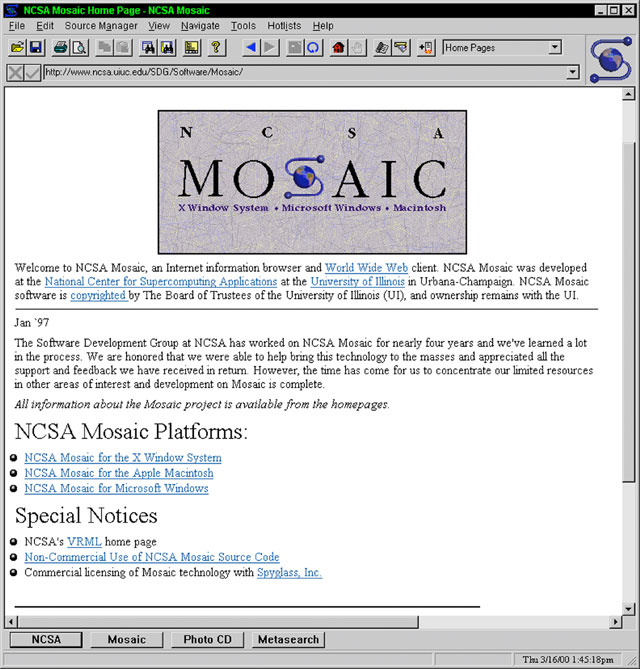
When Marc Andreessen left NCSA and formed a company to build web browsers, it was clear that their browser was the future. The first version was called Mosaic Netscape:
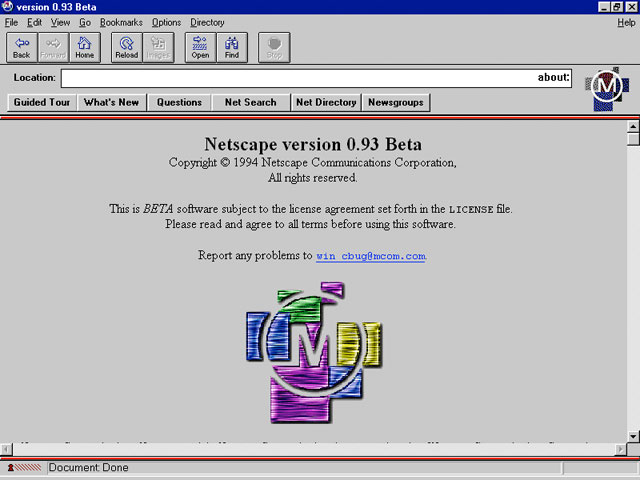
NCSA didn’t appreciate the new company’s use of the Mosaic name so they changed it to Netscape Navigator. This is a screenshot of Netscape 3, still my favorite web browser.
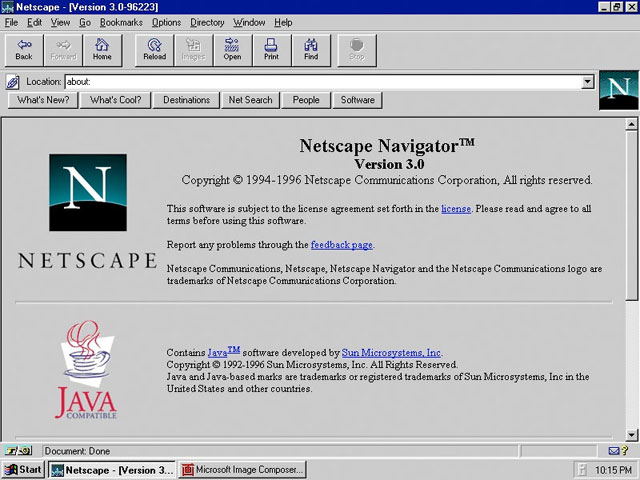
I continued to use Netscape 3 even after the release of Netscape 4, which was a such pile of junk that I eventually decamped for the sweaty embrace of Gates and Ballmer. You may not remember, but IE 4 was a pretty good browser. Microsoft won the browser wars, in part, because their browser was better than the other guy’s.
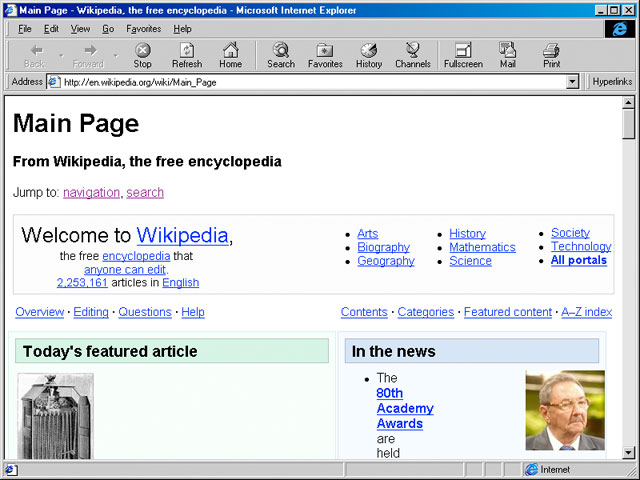
I used IE on Windows until I bought a iBook in 2002. The default browser for OS X was IE for Mac:
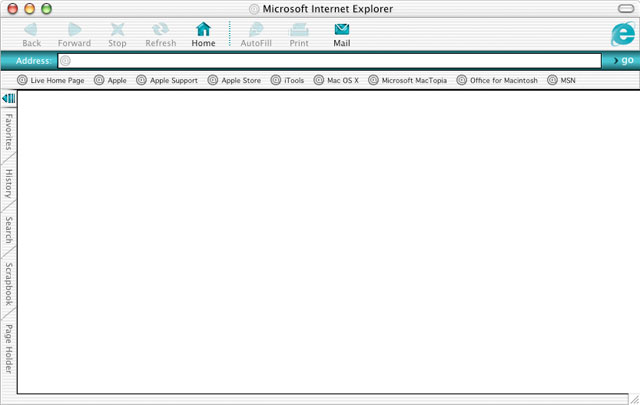
From IE for Mac, I moved to Chimera. I loved Chimera…it was fast and was the first browser I used that supported tabbed browsing.
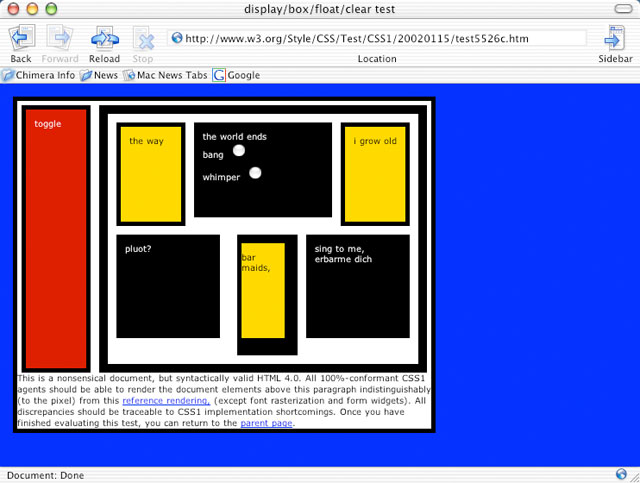
Chimera soon changed its name to Camino for legal reasons and I switched along with them.
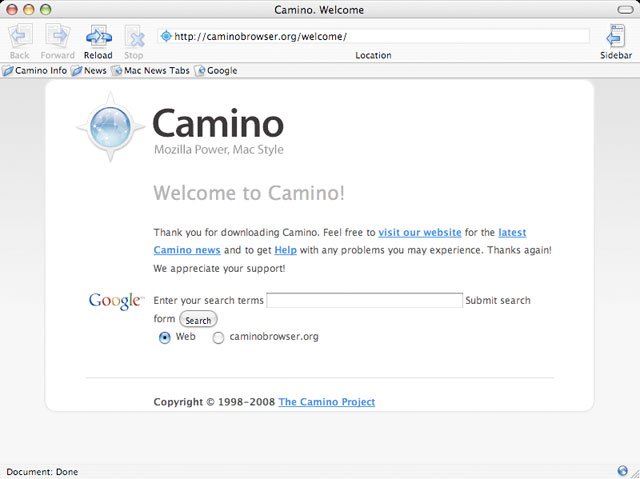
Eventually, the team and resources for Camino dried up, the release schedule slowed down, and the other browser makers caught up. At this point, I can’t quite remember what I switched to. I might have gone to Firebird (which was renamed Firefox), but I probably just went straight to Safari.
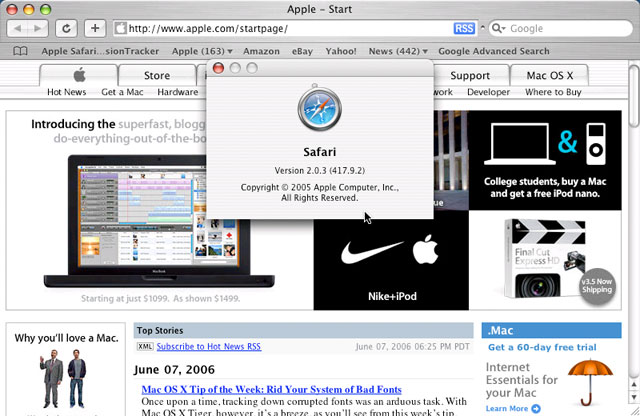
I used Safari for a long time until switching to Firefox a couple of years ago.
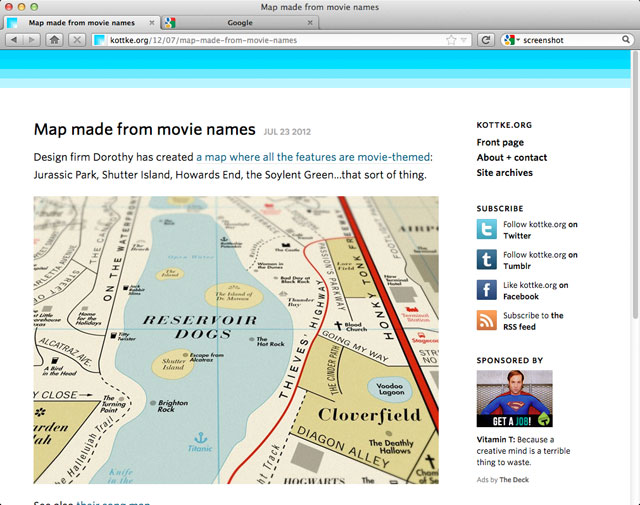
And today I’m making Chrome my main browser. I’ll still use Safari and Firefox for some stuff but links will open up on Chrome by default.
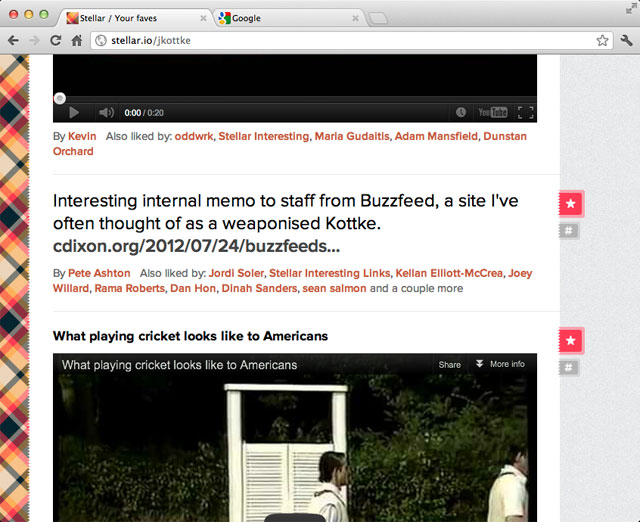
Chrome will probably be my last default browser on a non-mobile computer. Many of you use Mobile Safari much more than any desktop web browser; I’m not quite there but will be soon enough.
Living in a big city, you get to hear other people’s conversations all the time. These are private conversations meant for the benefit of the participants but it’s no big deal if they’re overheard on the subway. And you know what people talk about most of the time? In no particular order:
1. What they had or are going to have for breakfast/lunch/dinner.
2. Last night’s TV or sports.
3. How things are going at work.
4. The weather.
5. Personal gossip.
6. Celebrity gossip.
Of course you’d like to think that most of your daily conversation is weighty and witty but instead everyone chats about pedestrian nonsense with their pals. In fact, that ephemeral chit-chat is the stuff that holds human social groups together.
Ever since the web hit the mainstream sometime in the 90s, people have asked of each new conversational publishing technology — newsgroups, message boards, online journals, weblogs, social networking sites, and now Twitter — the same question: “but why would anyone want to hear about what some random person is eating for breakfast?” The answer applies equally well for both offline conversation and online “social media”: almost no one…except for their family and friends.
So when you run across a Twitter message like “we had chicken sandwitches & pepsi for breakfast” from someone who has around 30 followers, what’s really so odd about it? It’s just someone telling a few friends on Twitter what she might normally tell them on the phone, via email, in person, or in a telegram. If you aren’t one of the 30 followers, you never see the message…and if you do, you’re like the guy standing next to a conversing couple on the subway platform.
P.S. And anyway, the whole breakfast question is a huge straw man periodically pushed across the tracks in front of speeding internet technology. There is much that happens on Twitter or on blogs or on Facebook that has nothing to do with small groups of people communicating about seemingly nothing. Can we just retire this stupid line of questioning once and for all?
(Would you like to post this link to Twitter?)
Update: From Twitter, two pithier reformulations of the above:
@phoutz: If Twitter is banal it is because you and I are banal (It’s called social norming)
@thepalephantom: The “no one cares what you’re doing” proclamation is a solipsists way of saying “i don’t care”
Update: Three related articles. How the Other Half Writes: In Defense of Twitter by Geoff Manaugh of BLDGBLOG (thx, @secretsquirrel):
Again, I fail to see any clear distinction between someone’s boring Twitter feed - considered only semi-literate and very much bad — and someone else’s equally boring, paper-based diary — considered both pro-humanist and unquestionably good. Kafka would have had a Twitter feed! And so would have Hemingway, and so would have Virgil, and so would have Sappho. It’s a tool for writing. Heraclitus would have had a f***ing Twitter feed.
Twitter: Industries of Banality by Struan McRae Spencer of Vitamin Briefcase:
Living with friends and colleagues would be a cheap alternative to living alone. People generally don’t do it because it’s not a good thing for humans to do. We are genetically predisposed to need time in solitude occasionally. So instead of living with your friends and colleagues, try living with their disembodied thoughts floating around on your computer and popping up on your desktop every fifteen, thirty, sixty, (manual refresh), minutes. Fellowship exists to provide us with relief from solitude and our individual pursuits. Living in a state of constant fellowship with hundreds, if not thousands of people who have known you (or not) across various stages of your life becomes an insurmountable problem the longer you try to do it.
To Tweet or Not To Tweet by Maureen Dowd of the NY Times, the essay that finally set me off in the first place:
Do you ever think “I don’t care that my friend is having a hamburger?”
In the past week, both Joshua Schachter and Matt Haughey published articles that were excerpted in the Voices section of All Things Digital, a web site owned by Dow Jones and run by Kara Swisher and Walt Mossberg of the WSJ. Each excerpt was accompanied by a link to the original articles. Schachter and Haughey both reacted negatively to All Things Digital’s posting of their work. Andy Baio has collected responses from Schachter, Haughey, All Things Digital’s Kara Swisher, other writers whose stuff has been excerpted in the Voices section, and a couple other long-time online writers. Merlin Mann’s comment on Twitter sums up what the independent writers seem to be irritated with:
Republishing online work without consent and wrapping it in ads is often called “feed scraping.” At AllThingsD, it’s called “a compliment.”
It does suck that ATD’s linking technique makes it appear as though Schachter and Haughey are in the employ of Dow Jones and that DJ has the copyright on what they wrote. ATD should make the lack of affiliation more clear. Other than that, is the ATD post really that bad? In many ways, All Things Digital’s linking technique is more respectful of the author of the original piece than that of a typical contemporary blog. For comparison purposes, here are screenshots of Schachter’s original article as linked to from a typical blog (in this case, Boing Boing) and by All Things Digital.
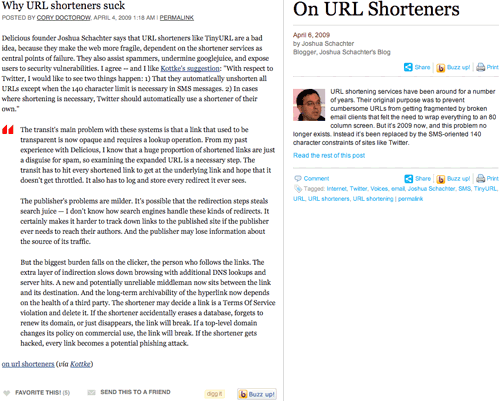
Go read both posts (ATD, BB) and then come back. With its short excerpt and explicit authorship (i.e. there’s no doubt that Joshua Schachter wrote those words), the ATD post is clearly just an enticement for the reader to go read the original post. On the other hand, BB’s post summarizes most of Schachter’s argument and includes an extensive excerpt of the juiciest part of the original piece. The post is clearly marked as being “posted by Cory Doctorow” so a less-than-careful reader might assume that those are Doctorow’s thoughts about URL shorteners.
[Metaphorically speaking, the ATD post is like showing the first 3 minutes of a movie and then prodding the viewer to go see the rest of it in a theater while BB’s post is like the movie trailer that gives so much of the story away (including the ending) that you don’t really need to watch the actual movie.]
What ends up happening is that blogs like Boing Boing — and I’m very much not picking on BB here…this is a very common and accepted practice in the blogosphere — provide so much of the gist and actual text of the thing they’re pointing to that readers often don’t end up clicking through to the original. To make matters worse, some readers will pass along BB’s post instead of Schachter’s post…it becomes, “hey, did you see what Boing Boing said about URL shortening services?” And occassionally (but more often than you might think) someone will write a post about something interesting, it’ll get linked by a big blog that summarizes and excerpts extensively, and then the big blog’s post will appear on the front page of Digg and generally get linked around a lot while the original post and its author get screwed.
So I guess my question is: why is All Things Digital getting put through the wringer receiving scrutiny here for something that seems a lot more innocuous than what thousands of blogs are doing every day? Shouldn’t we be just as or more critical of sites like Huffington Post, Gawker, Apartment Therapy, Engadget, Boing Boing, Buzzfeed, Lifehacker, etc. etc. etc. that extensively excerpt and summarize?
Update: I’m pulling a couple of quotes up from the comments so that the opinions of the people involved aren’t misrepresented.
Joshua Schachter:
I really just objected to the byline on the ATD thing. It made it appear that there was a relationship when there wasn’t. If there is curation, the curator should be the one noted as making the choices.
Andy Baio:
All the complaints stem from the affiliation issue. Running ads and having comments on an excerpt are only an issue if it’s presented as original content, instead of curation. Put an editor’s name on there, remove the author photos, throw it in a blockquote, and all these complaints go away.





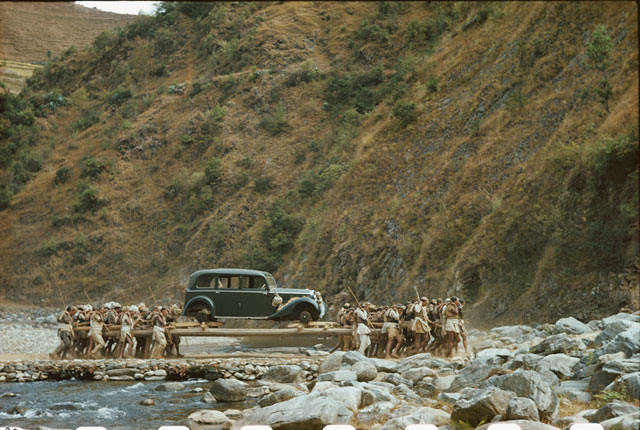
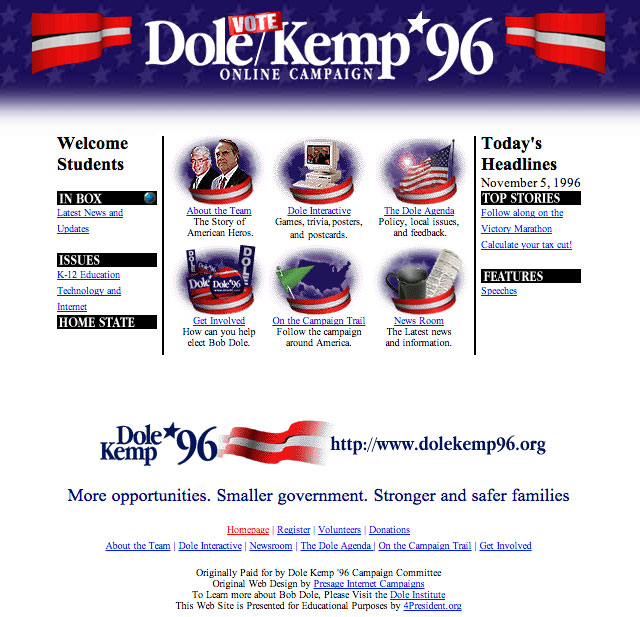










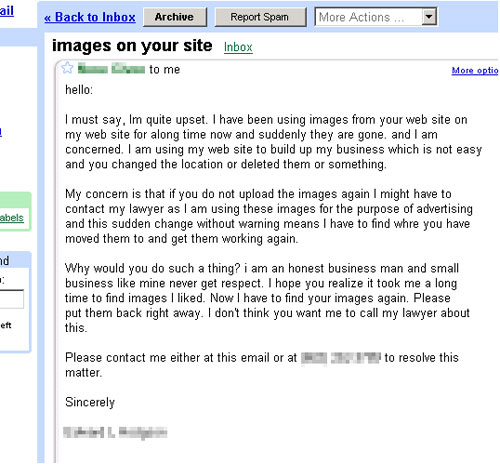

Stay Connected